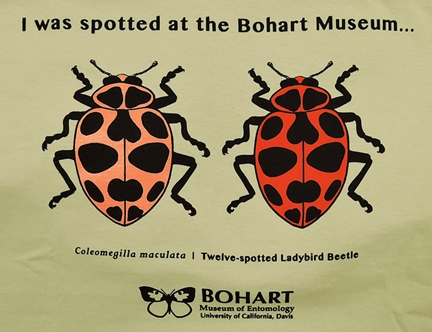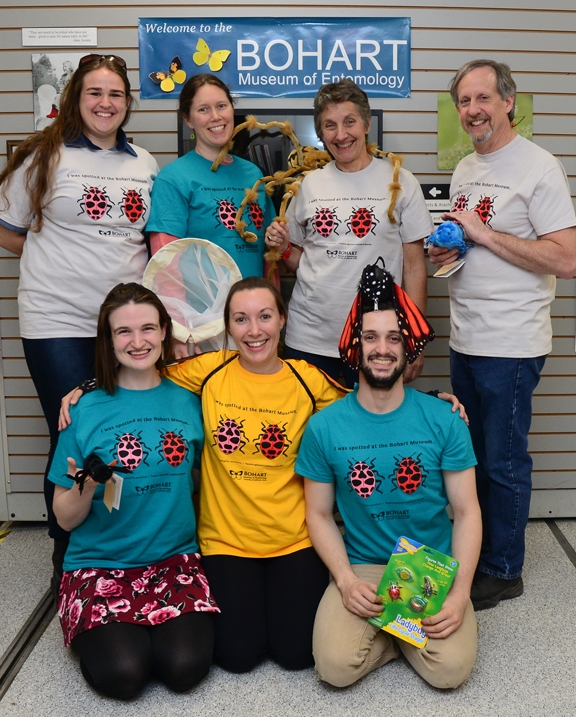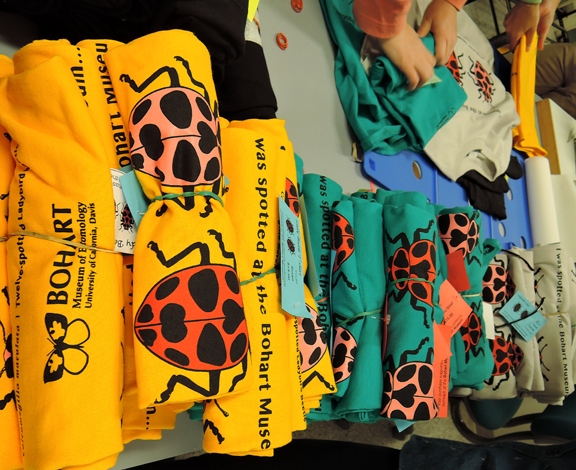
No, don't contact your local opthamologist. Contact your local entomologist.
This is Bug Country.
What's new--and spotted--at the Bohart Museum of Entomology--is a t-shirt adorned with two 12-spotted lady beetles (aka ladybugs).
Lynn Kimsey, director of the Bohart Museum and a UC Davis professor of entomology, points out that this native American beetle, Coleomegilla maculate, is commonly known as the “pink-spotted beetle” or the “12-spotted beetle.”
"Think pink" because most of these species are pink.
The t-shirt is the newest item in the Bohart Museum's gift shop. It comes in toddler, youth and adult sizes, with all proceeds benefitting the museum's many educational and outreach activities. It was drawn by graduate student Charlotte Herbert and designed by Fran Keller, assistant professor at Folsom Lake College who received her doctorate in entomology from UC Davis.
What about that beetle? Well, it's spot on. On each of the two wing covers (elytron) are six black spots.
Like other lady beetles, it's a predator. It gobbles up aphids, along with mites, scale insect insect eggs and small larvae. You can find it on such aphid-infested crops as wheat, sorgum, sweet corn, alfalfa, soybeans, peas, beans, cotton, potatoes, cole crops, tomatoes, asparagus and apple. “Reported prey include pea, green peach, melon (cotton), cabbage, and potato aphids and greenbug; eggs of European corn borer, imported cabbageworm, fall webworm, and corn earworm; asparagus beetle, Mexican bean beetle, and Colorado potato beetle eggs and larvae,” says BugGuide.net.
The pink-spotted or 12-spotted beetle, however, is quite unusual and not just due to its color and spots. Up to 50 percent of its diet can be plant pollen! Says BugGuide.net: “This is the only North American lady beetle that can complete its life cycle on plant pollen. Common pollen food sources are dandelion, squash, corn, and lily....Because pollen is an essential component of the diet of Coleomegilla, the planting or preservation of refuges, or interplantings, of early-flowering species with a high pollen load may be beneficial especially to provide a food source during late spring before the build up of aphids. Flowering dandelions, for example, have been recorded as a heavily used pollen source for dispersing adults in late spring potato fields.”
Meanwhile, back at the Bohart. Part of the UC Davis Department of Entomology and Nematology, the Bohart Museum is located in Room 1124 of the Academic Surge Building on Crocker Lane. It's the home of nearly eight million insect specimens, collected globally; a live “petting zoo” starring such critters as Madagascar hissing cockroaches, walking sticks and taranatulas; and year-around gift shop stocked with T-shirts, sweatshirts, books, jewelry, posters, butterfly habitats, insect-collecting equipment and insect-themed candy.
The museum, named for its founder, noted entomologist Richard M. Bohart (1913-2007, emeritus professor at UC Davis, traces its history back to 1946. It's open to the public Mondays through Thursdays from 9 a.m. to noon and 1 to 5 p.m. Admission is free.
To accommodate the public, the family friendly (and bug friendly) Bohart Museum holds open houses on specified weekends throughout the year. The next weekend open house (and the last of the 2016-2017 academic year) is Saturday, April 22. Set from 10 a.m. to 3 p.m., the open house is part of the 103rd annual campuswide UC Davis Picnic Day.
For more information on the Bohart Museum, contact (530) 752-0493 or bmuseum@ucdavis.edu. The website is http://bohart.ucdavis.edu/
Attached Images:

The Bohart team includes (front, from left) graduate students Charlotte Herbert and Jessica Gillung and undergraduate student Wade Spencer. In back (from left) are UC Davis biology student Emma Cluff; Tabatha Yang, education and outreach coordinator; Bohart Museum director Lynn Kimsey, professor of entomology; and Steve Heydon, senior museum scientist. (Photo by Kathy Keatley Garvey)

Seeing spots--scores of t-shirts are lined up, ready to be placed in the gift shop. (Photo by Kathy Keatley Garvey)